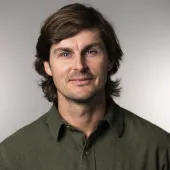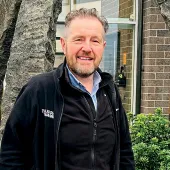The Rise of SigmaRoc

First published in the March 2018 issue of Quarry Management as On The Rise
SigmaRoc, the AIM-listed construction materials group, are rapidly becoming a recognized name in the UK mineral products sector. QM spoke to Max Vermorken, chief executive officer, about how the business is consolidating its position in the heavy construction materials market and the challenges and opportunities going forward
Led by a team of industry veterans and experts, SigmaRoc have become one of the fastest-growing businesses in the UK building materials market.
Established in August 2016 as an AIM-listed venture, the company has adopted a ‘buy-and-build’ strategy, targeting smaller niche material firms (eg aggregates, concrete and cement) that will not only contribute to the growth of the business, but also provide strategic opportunities to create shareholder value and increase their returns.
SigmaRoc have completed and successfully integrated four value-creating acquisitions to date: Ronez Ltd (from Aggregate Industries); Topcrete and their subsidiary Allen Concrete; and the launch of SigmaGsy, the company’s dedicated bulk-shipping division.
More recently, the materials group has purchased Ipswich-based Poundfield Products (Group) Ltd, specialists in patented precast and prestressed concrete products, for £10.25 million.
‘Our acquisitions are highly targeted,’ said Max Vermorken, chief executive officer of SigmaRoc. ‘We buy independent, well-managed companies with established customer relationships, high profitability and strong market presence. Importantly, they must share the SigmaRoc core values of being self-contained, well-managed companies underpinned by assets and people that drive safety, product quality, innovation and excellent customer care.’
Mr Vermorken is no stranger to acquisitions, mergers and takeovers, having helped undertake one of the biggest mergers in building materials industry history – the creation of LafargeHolcim in 2015. Amalgamating the individual portfolio of assets of Holcim and Lafarge, their combined resources, and the high-quality products and service offerings, into a single multinational corporation was, as expected, hugely challenging.
As project lead on the merger process covering the UK and northern Europe, one of Mr Vermorken’s key tasks was to hive down and integrate the two large asset portfolios of each company, which included the divestment of Lafarge Tarmac’s assets (with the exception of Cauldon and Cookstown plants) to CRH.
The merger between the building materials giants also saw Leicestershire-based Aggregate Industries become a cement producer for the first time in the UK market. It followed the successful transfer of ownership of two Lafarge cement facilities in Cauldon, Staffordshire, and Cookstown, Co. Tyrone, along with a quarry at Cauldon Low and a cement terminal at Belfast Docks.
‘Mergers are never a straightforward process and the creation of AI’s cement and concrete products division, as part of the conditions for the Holcim/Lafarge arrangement, was extremely challenging for everyone involved,’ commented Mr Vermorken.
‘As part of the integration process, we had to oversee the transfer of 250 employees from the existing operations to Aggregate Industries. Thankfully, I had a highly skilled management team around me for the successful cement asset integration at the Cauldon and Cookstown sites.’
Indeed, when LafargeHolcim was officially launched (15 July 2015) around the globe, Aggregate Industries’ newly formed cement operations were among the first entities to formally merge across the organization.
‘We ensured all elements of the cement production process were moved over to AI’s own high-tech IT infrastructure without harming the operations of the cement works,’ continued Mr Vermorken. ‘The support received from my team and also the teams at Lafarge-Tarmac was critical to this success.'
Holding a PhD in financial economics from University College London (UCL), and having graduated with Bachelor and Master degrees in both civil engineering and financial economics and management, from UCL and University of Brussels, respectively, it is perhaps no surprise to learn that Mr Vermorken initially decided to pursue a career in corporate finance.
‘Prior to my strategy advisor role at Holcim/Aggregate Industries, I spent the early part of my career working in the private equity sector at Luxembourg-headquartered The Genii Group,’ he said. ‘As I climbed up the private equity ladder and my role evolved, I realized that working for a larger-scale and more challenging business would be both fascinating and a good next step in my career. So, when an opportunity arose at Holcim, I decided to take up the business advisory position.’
It was a decision that Mr Vermorken has never looked back on. However, successful professionals within the quarrying and mineral products sector are acutely aware of how to develop their skills in different areas to keep their careers moving forward, and Mr Vermorken set his sights on addressing some of the industry's challenges slightly differently. ‘After I left LafargeHolcim, I initially spent a few months putting together a business plan for the SigmaRoc venture, strategizing how to grow the company and building a senior management team fit for the new group,’ he explained.
‘As the SigmaRoc venture creation began to take shape and increasingly become a viable business proposition, I had some key industry people interested in joining the group, which has helped me to create a very strong management structure.
‘It is important we position the venture for long-term success in what is already a highly competitive market and I am delighted with the core management team in place at SigmaRoc. Their combined skills, know-how and experience in the wider quarrying and building materials sectors will be invaluable to a small but growing organization like ours.’
The seven-strong management team includes: David Barrett, executive chairman; Charles Trigg, technical director; Garth ‰ Palmer, finance director; Dominic Traynor, non-executive director; Patrick Dolberg, non-executive director; and Gary Drinkwater, non-executive director.
In David Barrett – who co-founded London Concrete (now part of Aggregate Industries), the leading concrete suppliers in the English capital – SigmaRoc have one of the industry’s leading pioneers on their board.
The company has also recruited Charles Trigg, former group head of capex at LafargeHolcim for Northern Europe, who brings significant international operational knowledge and management experience to the group, along with Dominic Traynor, a corporate lawyer specializing in listings/takeovers, mergers and acquisitions, and corporate finance.
Another high-profile board appointment has been Patrick Dolberg, who has held a number of senior- and top-level management positions in cement production, including CEO of Holcim US, and Group ExCo member for Holcim Europe.
Lean, mean and client-focused
Mr Vermorken is excited about the opportunities that lie ahead. Aggregates remain an attractive business, especially in light of the recent mergers in the construction materials industry which have led to a raft of divestments, meaning that smaller firms can be picked up at interesting prices.
Like all directors, Mr Vermorken has big plans for the future and believes the company is in a perfect position to expand quickly and flex its muscle in the marketplace.
‘The £45 million Ronez acquisition was a major milestone for us and it is our cornerstone asset that will provide us with the platform from which to grow our business further, whilst generating cash flow,’ he commented.
Ronez currently operate two quarries – St John’s in Jersey (also known as Ronez Quarry) and Les Vardes in Guernsey – as well as multiple associated and downstream businesses on both islands. Ronez are in a strong position to continue the supply of essential minerals to the construction industry on the Channel Islands, with reserves and resources that will allow them to operate both quarries for several decades.
Recently, the firm announced plans to establish a new quarry site on Chouet headland, in Guernsey, as part of plans to develop its resources for future production.
SigmaRoc believe production at Chouet could start as early as 2021 and that the quarry would have a lifespan of several decades, during which time hard rock could be extracted from both free-held mineral and further mineral held by the States of Guernsey.
Ronez have already started exploratory drilling to evaluate the site’s potential, which will form an essential part of the planning application. ‘Quarrying is strategically important to Guernsey and the new quarry will help us remain a strategic supplier of key local materials,’ said Mr Vermorken.
Another significant step forward for the materials group in the British Isles and northern Europe markets has been the launch of SigmaGsy – a business division focused on supplementing the bulk-shipping requirements of cement majors and other partners in the region, while supporting the shipping needs of Ronez.
SigmaRoc’s recent announcement to acquire Poundfield Products marked yet another milestone in their buy-and-build strategy, as the materials producer grows and consolidates its position in the market. For SigmaRoc, it is important that the company’s growth strategy is based on identifying and driving market transitions, both domestically and internationally.
‘On a European level, we are looking to acquire niche businesses in more mature markets that provide a steady and reliable income stream. Currently, we are exploring a number of opportunities in Germany and the Benelux, where we can deploy capital into high-quality businesses; accelerating our growth and adding a valuable cluster of assets with a good geographical fit to the existing footprint of the group. Diversifying our operations, and focusing and capturing these market transitions, will allow us to operate more effectively and make the best use of our assets.’
A perfect fit
Mr Vermorken may have a long shopping list of businesses but SigmaRoc have developed a well-thought-out acquisition strategy based on a two-pronged approach. First, the group targets cash flow generated materials businesses with strong operating and trading traditions. Secondly, it approaches niche companies who manufacture their own brands or proprietary products.
‘In terms of our purchasing budget, we look at anything from £1 million up to £50 million per transaction,’ commented Mr Vermorken. ‘The target SMEs need to be a decent sized player in the local market and they must have significant potential to grow in their respective markets. Importantly, we want to buy businesses that fit with our entrepreneurial culture and business ethos based on product quality, innovation and exceptional customer service.’
The management team strongly believe in a decentralized company structure in which key decision-making authority and operational responsibility are delegated to the subsidiaries.
‘Our acquired companies operate in clusters – but retaining their name, culture and management when they become part of the group,’ explained Mr Vermorken. ‘A major benefit of a decentralized management philosophy is that localized businesses have more ability to adapt or react quickly to changes in the local markets. Bringing those businesses together under one umbrella brings a second benefit – scale. Where an SME alone will not have the required scale, a group will.’
He continued: ‘The logic for decentralization across our organization runs along both geographic and product lines. Aggregates businesses in specific locations often face different challenges, from logistics and operational processes to pricing and local regulations. A decentralized management model allows for efficient and effective decision-making by managers closest to the issue.
‘It was one of the key components in formulating our business strategy and the successful integration of Ronez and Topcrete are good examples of the operating benefits that decentralization brings to the group.’
While SigmaRoc’s acquisitions strategy opens up new market opportunities in the heavy building materials sector, Mr Vermorken believes there is a need for the company to operate in an innovative manner if it wants to stand out and stay ahead of the crowd.
‘We are fully committed to bringing new ideas, solutions and processes to the construction supply chain, and part of our investment strategy, is to focus on businesses at the forefront of innovation in the industry,’ he enthused. ‘Materials producers, plant manufacturers and contractors all have an increasingly important role in developing innovative solutions to meet the changing needs of the building sector.’
One of the biggest challenges facing quarry operators and materials producers is to help the construction industry to operate more sustainably (eg low-carbon, efficient, advanced technology) – something that Mr Vermorken sees as a potentially strong growth area for SigmaRoc.
‘The recent acquisition of Poundfield Products is a case in point,’ he said. ‘They are one of the UK’s leading innovators in precast and prestressed concrete products, supplying everything from retaining wall systems through to marine/coastal sea defences and interlocking ‘L’ shape concrete panels.
‘Every product and manufacturing method in their portfolio is patented, and one of the company’s recent successes has been the establishment of the block and beam flooring department.’
Mr Vermorken continued: ‘The division offers an on-site design and made-to-measure flooring service, working closely with housebuilders and commercial property developers. These bespoke services provide fast turnaround of new floor orders and greater flexibility in build specifications, and increase the customers’ production and operating efficiencies.’
Safety first
Workplace health and safety is, undoubtedly, the highest priority for any quarry operator. While the industry has made significant progress as part of the ‘Target Zero’ initiative, there is still a lot of work to be done to create and/or maintain a sustainable safe working environment for the benefit of all employees, subcontractors and visitors.
As a new player in the market, Mr Vermorken highlighted the importance of delivering health and safety best practice across the SigmaRoc group and to ensure that safety is at the forefront of everything they do.
‘Workforce engagement is a significant factor in improving overall health and safety and we encourage our staff to take ownership of their behavioural safety and actions, and challenge them on how they can remove hazards in the workplace, or where that is not possible, reduce the risks that may arise from them,’ said Mr Vermorken.
‘We currently have close to 300 employees and everyone in the workforce has a key part to play in helping to deliver a strong safety culture embedded across the organization.’
SigmaRoc clearly value employees as their most important assets and the company has developed a number of resources, such as the Gold Card scheme, which is used as a ‘suggestion box’ for staff to not only highlight potential safety improvements, but also share good working practices.
‘At SigmaRoc, we strongly believe employee engagement and motivation can play a part in delivering continuous improvements in our business performance, health and safety, skills and innovation,’ commented Mr Vermorken. ‘The Gold Card initiative encourages worker participation at all levels – stimulating creativity, helping to generate ideas and bringing more innovation to the company – all of which will help drive the business forward.’
- Subscribe to Quarry Management, the monthly journal for the mineral products industry, to read articles before they appear on Agg-Net.com








